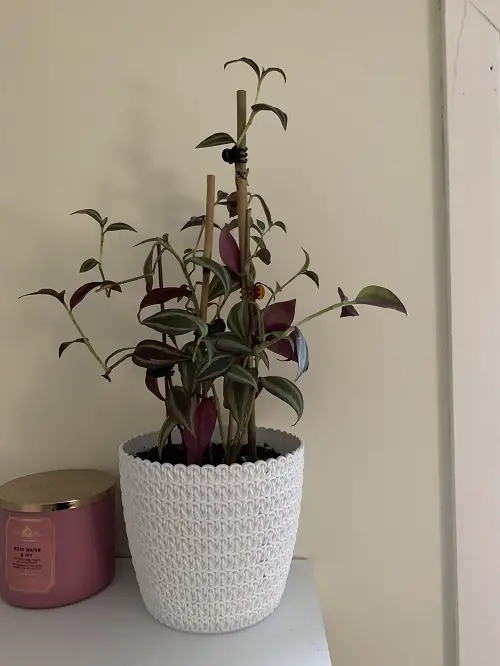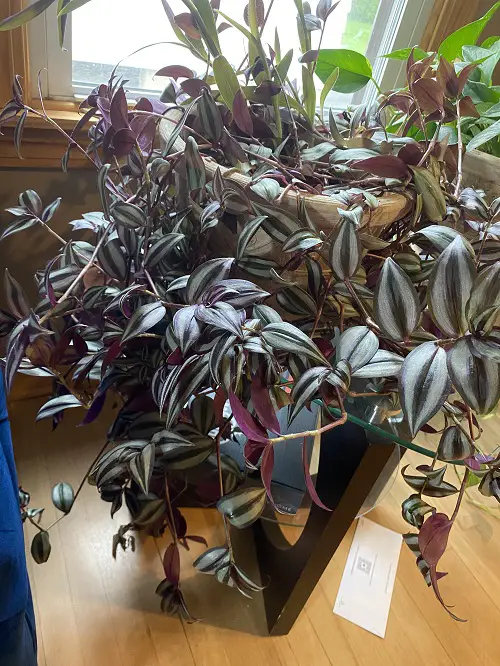Do you have a Leggy Wandering Jew plant and want to know How to Fix It? This article is just for you!
You may notice leggy growth in your Wandering Dude plant for various reasons. Before it gets worse, learn how to make it lush and colorful again with these tips.
What is a Wandering Dude?
Wandering Dude is the common name for different varieties of Tradescantia zebrina, a species of fast-growing creepers that like to … wander!
When left undisturbed outdoors, these vining plants can become quite invasive, colonizing new areas and slow-growing vegetation. However, their zebra-patterned leaves in silver, green, and magenta make them wonderful houseplants.
Why Is My Wandering Dude Leggy?
Also called the Inch Plant, it sometimes grows with skinny, elongated stems but barely any leaves. The plant becomes leggy for reasons that differ according to the growing conditions and environment.
Some of the key causes include insufficient light, incorrect watering, and a lack of essential nutrients. This drifter stretches out in the hope of finding these resources for self-sustenance.
Let’s take a look at what could be bothering your wandering dude and how to fix it!
How To Fix A Leggy Wandering Dude
1. Fix the Lighting Condition
Insufficient light is a number one culprit for leggy growth, where the stems stretch out with far fewer leaves. Here’s how to give your plant the light it needs to flourish.
Aim for bright, indirect light for at least 6-8 hours daily. Think of a spot near any bright window. If it’s south-facing, keep your plant far from intense sun exposure.
This will provide ample light for healthy growth without the harsh intensity of direct sunlight. Direct sun, especially during the afternoon, can scorch the leaves, so, again, avoid west—or south-facing windows or keep the plant slightly away.
If your house doesn’t have sufficient natural brightness, you can use a grow light.
2. It could be a Watering Issue
Both overwatering and underwatering can stress your plant, affecting its stable growth and making it leggy. However, it’s mostly consistent overwatering in the majority of cases!
Establish a consistent watering routine that keeps the soil evenly moist but slightly around your leggy wandering dude. A simple rule is to water the plant when the top inch of the soil feels dry so that it doesn’t waterlog; a good way to find it is by inserting your finger before saturating. During winter, reduce the frequency of watering as the plant’s growth slows down.
Also, determine the frequency of watering according to its growing conditions. For example, if your tradescantia zebrina is placed in a shadowy spot with little air circulation, water less frequently. If your plant is exposed to a mix of direct and indirect sunlight with good air circulation, water more often!
3. Proper Fertilization

This native of Mexico and Central America thrives in rich, well-draining soil. So, if it appears leggy and weak due to insufficient nutrients, try revitalizing your moribund plant with a water-soluble fertilizer at least twice a month during its active growing season.
Use a fertilizer that contains nitrogen, phosphorus, and potassium in equal proportions. Dilute this aqueous mixture to a quarter or half its recommended strength to prevent the leaves from getting burnt.
During fall and winter, reduce feeding frequency as the plant stops growing vigorously.
4. A Temperature too High or too Low
The wandering dude feels at home in tropical and temperate climates, preferring warm weather and humidity. Sudden fluctuations stress the plant out, leading to leggy growth. A consistent temperature range between or around 60-75°F (15-24°C) will ensure healthy growth.
While this tough plant can tolerate extreme temperatures below 32 F (0 C) and above 100 F (38 C) for a while, it’s best to maintain a steady range. Start caring for your tradescantia when your thermometer dips below 50 F (10 C) or hits over 85 F (29 C).
Avoid placing the plant near drafts, heaters, or air conditioners. You can also use a thermometer to monitor the temperature around your plant and make adjustments as needed to ensure a stable environment.
This nomadic species mostly cannot tolerate frost; this is why if you live in a cold climate, it’s best to overwinter it indoors.
5. Maybe it is Rootbound

Famous for its aggressive growth, at some point, your wandering dude will likely outgrow its container, making it root-bound and hindering its nutrient uptake, thus making it leggy. Simply re-pot to a larger, spacious container with a well-draining, organic-rich potting mix to promote a lush growth habit.
If you want to utilize the same pot again, divide the rootball of your mother plant into 2 to 4 portions, providing each section enough roots and top growth equally, and plant them back in separate pots. It’s a nice way to have more of this amazing plant in your home.
6. Aging causes Leggy Growth
If your wandering dude becomes scraggly and lanky, it’s clearly time for a good haircut, as it can be due to aging; old growth in this popular plant often loses lackluster, and a strategic prune may help put back the bounce in your dude.
Identify the stems that are old and aging, excessively long or sparse, and make clean cuts just above a node (the point where leaves attach to the stem). This will help stimulate the plant to produce new shoots and leaves from the node, leading to fuller foliage.
Don’t forget to sterilize or thoroughly clean your pruning shears to prevent disease transmission, and read our comprehensive post that will guide you on growing a bushier wandering dude.
If you follow these steps, your wandering dude will come back to life handsome and happy! Don’t forget to share your own stories with this roving plant via the comment section below!



